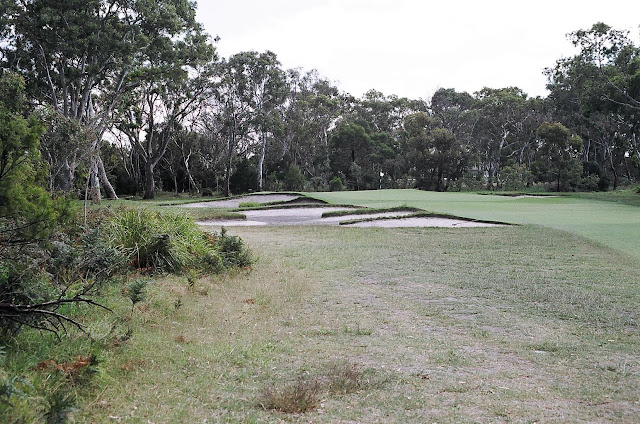Woodlands is laid out over fairly subtle terrain by comparison to her Sandbelt sisters, and features a strong collection of short par fours and an excellent collection of one-shotters. The bunkers are visually appealing and in a few instances, perfectly highlight the strategic element of the design. The golf course is situated on a fairly small acreage, but is routed in such a fashion as to play to each cardinal point of the compass and the quartering directions in between. A less desirable consequence of the tight acreage are the walk backs to the second and sixth tees, and the awkward relationship between the thirteenth and fourteenth holes, but these are not knocks on the holes themselves and only detract marginally from the overall walking experience.
 |
| The first in a sweeping dogleg left that is best approached from the outside of the turn. |
 |
| These fairway bunkers at No. 2 depict typical bunkering throughout the course, no rough separating it from the fairway, wild shapes, attractive and incorporation of native vegetation. |
 |
| A staple of the Australian Sandbelt, the one-shot hole demanding an accurate approach to a target surrounded by bunkers. Here, the fifth at Woodlands. |
 |
| The seventh narrows in the landing area and features a testing front right pin guarded heavily in front and directly behind owing to a small bunker eating into the green surface. |
 |
| The eighth is a long par three with plenty of room to right to run an approach onto the green or bail-out. Replete with intimacy, the third green and fourth tee reside immediately left of the green. |
 |
| The tenth is another long par four sporting a group of greenside bunkers that infringe upon the line of play diagonally, complicating long approach shots. |
 |
| The eleventh is a short par three, a must have in the Australian Sandbelt. |
 |
| For those players successfully challenging the fairway bunkers on the short par-four thirteenth, the green is approached from a more advantageous angle. |
 |
| Ornately shaped bunkers flank both sides of the approach into the fourteenth green, providing much needed visual contrast over a flatter section of the property. |
 |
| Another strong par three awaits at the seventeenth where the green is protected by deep bunkers and short grass swales. |









Thank you Tyler for a very welcome commentary on this wonderful golf course that has stood the test of time over 102 years. It is not understood by the Australian golfing community that Woodlands has been on this site since it was foundered in 1913 and is the third club on the famed Melbourne sand belt after Royal Melbourne GC in 1898 and Metropolitan in 1908. It was foundered by George Hunter Rogers who lamentered in 1913 that as there was no golf course in the district............................!
ReplyDeleteBill Atherton
Mordialloc
Thanks for taking the time to read my blog Bill. Woodlands is a wonderful golf course that is overlooked my too many who venture to Melbourne to play the city's excellent collection of golf courses. I certainly hope to get back there one day to experience it's charm once again.
DeleteI know Tom Doak has been hired to consult at the club, has any work been done?
Regards,
Tyler Kearns